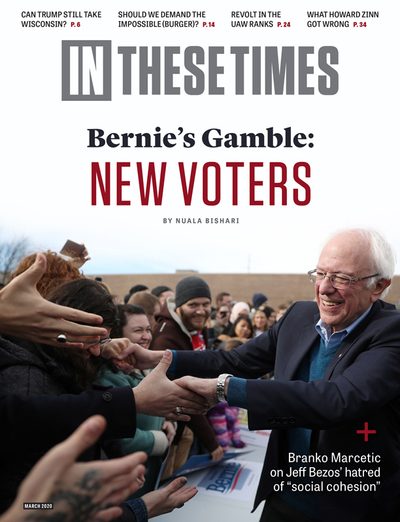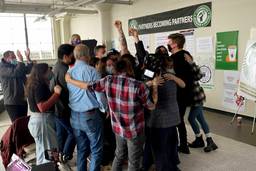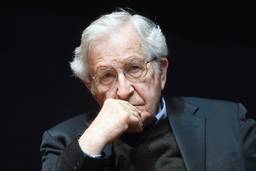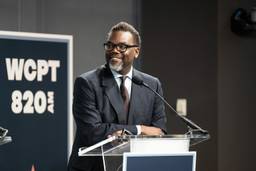How the UAW Went From a Militant, Trailblazing Union to a Corrupt, Dealmaking One
The 50-year decline that led to Gary Jones’ indictment.
Chris Brooks
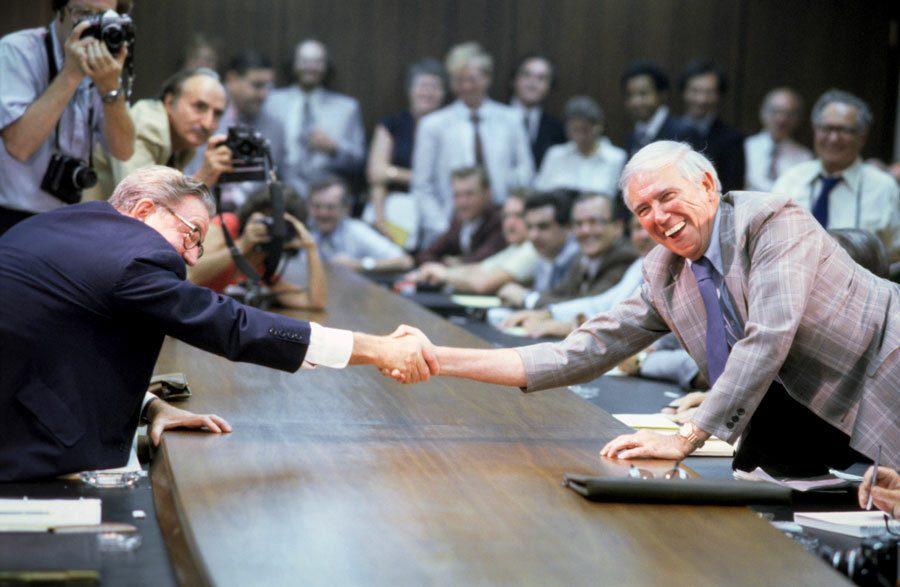
UAW president Douglas Fraser (R) kicks off talks with GM’s chief negotiator George B. Morris (L) on July 17, 1979. The 1970s saw the beginning of a slippery slope of UAW concessions and corruption. (Bettmann / Contributor / Getty)
Contract negotiations between the 400,000-strong United Auto Workers and Detroit’s Big Three automakers always kick off the same way: with ritualized handshake ceremonies in front of the press pool, the UAW president grinning with each automaker’s CEO.
But in 2015, the cozy routine at the UAW-Chrysler Training Center in Detroit devolved into an outright display of affection. UAW officials and Chrysler management flanked the stage (in matching polo shirts featuring interlinked organization logos) and merged into a sea of indistinguishable figures. Then, Fiat Chrysler CEO Sergio Marchionne pulled in UAW President Dennis Williams for a tight bear hug.
That night, things really started cooking.
The UAW team for bargaining with Chrysler, including lead negotiator and UAW vice president, Norwood Jewell, went out for dinner and drinks at London Chop House, an extravagant (and historic) restaurant and cigar lounge. Both Henry Ford II and former Ford (and then Chrysler) CEO Lee Iacocca have been among the dapper, A-list regulars to enjoy whiskey highballs there amidst the soft jazz and heavy cigarette smoke. Today, the restaurant — complete with working rotary phone booths (local calls only) — caters to the nostalgia of Motor City as the epicenter of global manufacturing, back when union leaders like Walter Reuther were household names.
The UAW’s night out resulted in a hefty tab — and Chrysler footed the $8,494.37 bill. That dinner is just one of the many examples of union leaders taking payouts, according to a federal probe by the Department of Justice. Marchionne, Williams, Jewell and at least a dozen others have been named in a long-running conspiracy by Chrysler to buy off the UAW. In a December 2018 memo, federal prosecutors described “a culture of corruption” in which “lavish entertainment and personal freebies, all paid for by the car company” were “the rule rather than the exception.”
The investigation also uncovered lucrative kickback schemes among union officials who awarded contracts for UAW-branded swag, like 58,000 gold watches that were left sitting in a warehouse. First, they would inflate an item’s on-paper cost; then, when a training facility jointly operated by General Motors (GM) and the UAW paid for the items, they would receive some of the cost difference. Finally, multiple union officials embezzled millions from the UAW itself through fraudulent purchases and reimbursements to finance lavish lifestyles. Between 2014 and 2017, officials spent over a million dollars of the membership’s money on resorts, golf, cigars, steak dinners and liquor.
To date, three Chrysler executives, nine union officials and the widow of a deceased UAW vice president have been convicted of crimes uncovered by the investigation. Just this week, the federal government brought charges against former UAW President Gary Jones, who resigned in disgrace less than two years into his term after the union brought charges against him that could have led to his expulsion. The Detroit News reports that Jones plans to plead guilty to his role in embezzling $1.5 million in members dues and will cooperate with the investigation of Williams and current UAW president Rory Gamble.
Right-wing anti-union propagandists have been eager to weaponize this scandal. When Volkswagen workers in Chattanooga, Tenn., were considering joining the UAW in June 2019, the corporate-backed Center for Union Facts purchased billboards around the plant and ads in the local newspaper targeting the union’s history of concessions and corruption, and even produced a video for social media featuring a shadowy “UAW whistleblower” with a voice modulated to sound like a baritone hell demon. “I would not bet on the promises made by the UAW that they will protect you because they will eventually sell you down the road for their own benefit,” the voice growls over news reports about a GM plant closure.
The U.S. Attorney’s Office, which is actively pursuing top UAW officials, has named the UAW itself as a conspirator, setting the stage for a possible government takeover. The government took a similar route 30 years ago to free the Teamsters from mafia control. Claiming that leaders of the 1.7 million member union had “made a devil’s pact with La Cosa Nostra,” then-U.S. Attorney Rudy Giuliani filed suit against the Teamsters under the Racketeer Influenced and Corrupt Organizations Act, threatening a government trusteeship. Teamsters for a Democratic Union, a rank-and-file caucus formed to fight concessions and corruption, successfully campaigned for a different solution. They helped negotiate a settlement in which the union constitution was changed so that top union leaders would be selected by members in a court-supervised, one-member, one-vote election, with a joint government-union board to investigate and prosecute corruption and election irregularities. Absent a similarly strong rank-and-file movement in the UAW, things could turn out much worse, especially under a Trump administration.
While the indictments continue for UAW leaders, rank-and-file members are left to wonder how their union — once renowned as one of the strongest and cleanest in the country — got to this point, and what to do next.
A Nation Built on the Automobile
The United States saw incredible economic growth in the three decades following the Second World War, and the UAW, more than any other union, set the terms and conditions of workers’ share of that prosperity. The postwar economy, down to the Interstate highway system, was predicated on that quintessential American product, the automobile.
At the center of this manufacturing boom was General Motors. GM held the number one spot on the first Fortune 500 list ever published, in 1955, and topped the list 37 more times over the next 45 years. GM became the largest private manufacturer in the world and the largest private employer in the United States. With Ford and Chrysler, the Big Three automakers were synonymous with U.S. heavy industry.
The UAW, founded in 1935, had meanwhile won a reputation as a fighting union through pitched street battles, plant occupations and militant strikes. It secured its first major contract, with GM, through what came to be known as the Flint sit-down strike of 1936 and 1937, in which 2,000 workers took over a plant and fought off armed police. Over the next decade, the union wrested contracts from a number of hostile and often violent employers, organizing “flying squadrons” of brawny unionists who protected strikers from company-hired thugs and police.
By 1955, the UAW had organized much of the domestic auto industry, including many suppliers, and had aligned the expiration dates of its contracts at all three major automakers. The Big Three then entered into something of a gentlemen’s agreement: If the UAW struck a deal with any one of them, the other two would match it. This “pattern bargaining” helped the UAW establish standards across the entire industry.
These UAW contracts heavily influenced the standards for steel, copper, aluminum, railroad, rubber and glass workers. Once the UAW won a large increase in wages or pensions, other industrial unions, like the Steelworkers, could fight for the same. The benefits even trickled down to non-union employers, who would match union pay and benefits hoping to remove the incentive to organize. For millions of workers across the country, the result was decades of unparalleled increases in their standard of living. The gains were especially significant for Black workers, whose numbers grew to make up 30 percent of the auto manufacturing workforce by the 1960s and who sought out union jobs in other industries in droves after the 1964 Civil Rights Act barred hiring discrimination on the basis of race, sex, religion and nationality.
By the mid-1970s, however, the post-war economic boom was over. High interest rates, rising unemployment, inflation, oil shocks and the influx of goods from rebuilt European and Asian economies triggered the largest recession since the Great Depression. Corporations, emboldened by high unemployment, went on the offensive. Democrats and Republicans alike championed deregulation and other employer-friendly policies, pushed by the newly formed Business Roundtable, a political powerhouse composed solely of Fortune 500 CEOs, and new conservative think tanks and political action committees. President Ronald Reagan’s merciless breaking of the air traffic controllers’ strike in 1981 broke the taboo on the permanent replacement of striking workers, undermining one of the most powerful tools in labor’s arsenal. Businesses also began putting the squeeze on labor costs, forcing concessions from unions.
By 1979, Chrysler was at a breaking point. It had increased production in the U.S. and overseas on vehicles that nobody was buying, running up a massive debt it couldn’t repay. The U.S. government brokered a deal to bail out Chrysler with a $1.5 billion loan — on condition that the company reinvent itself and come up with $2 billion in savings. A billion of those cuts came from UAW concessions.
Soon, the other two auto giants came knocking on the UAW’s door. Roger Smith, famed GM CEO featured in Michael Moore’s Roger & Me, stated bluntly to reporters: “You cannot have a two-tier wage industry.” Pattern bargaining, in other words, was not a one-way street; if Chrysler got concessions, GM expected them as well.
Soon, unions in every sector were flooded with demands for givebacks, even from profitable businesses. After all, who could say no to concessions if the mighty UAW had agreed?
In a 1982 Businessweek survey of several hundred corporate executives, one in five admitted that “although we don’t need concessions, we are taking advantage of the bargaining climate to ask for them.” In a few short years, employers dismantled the postwar accord of industrial pattern bargaining. By 1986, the “basic steel” agreement — which had imposed industry-wide wages, benefits and working conditions — had dissolved; the Steelworkers were back to negotiating with each company individually. The fallout rippled throughout the private sector, too, in rubber, coal, trucking and rail. From that point on, companies had no intention of going back to the “B.C.” era, Before Chrysler. Again, Roger Smith summed things up candidly, quipping to the Wall Street Journal that “all of us are dedicated to keeping our companies lean and mean.”
The UAW’s pattern agreement with the Big Three remained, but Chrysler, Ford and GM’s share of the domestic auto industry shrank as foreign-owned auto companies expanded in the United States. Startlingly, over the past 40 years, the UAW has been unsuccessful in organizing any of the foreign-owned car companies that have located their facilities in the South, where politicians are hostile to unions (and generous to corporations through public subsidies). Collectively, foreign-owned automakers now produce more vehicles for the U.S. market and employ more workers than the Big Three combined, and more than 80% of the auto industry is non-union. As a result, the Big Three automakers have pushed hard, especially during the 2008 economic crisis and subsequent auto bailouts, for the UAW to bring labor costs in line with their non-union competitors, rather than the other way around.
For decades, companies got the UAW to cave to concessions under the threat of plant closures and outsourcing, then went on to close plants anyway, in a vicious cycle that Priscilla Murolo, professor of history at Sarah Lawrence College, describes as a “protection racket.” “The employer says, ‘[Give] us this and we protect you.’ But the crime boss keeps coming around and upping the cost until they burn you down. The unions were foolish to go along with it.”
From Sweetheart to Subsidiary
Walter Reuther, a social democrat, skilled politician and savvy negotiator, was elected UAW president in 1946. With Reuther at the helm, the Autoworkers secured historic contracts that created what came to be known as the “private welfare state,” providing UAW members with health insurance, pensions, supplements to their unemployment insurance and paid vacations. Reuther pushed for a four-day work week as early as the 1950s, and by his untimely death in a plane crash in 1970, the Autoworkers were inching toward a guaranteed annual wage.
The UAW was rightly known as a “clean” union. Walter and his brother, Victor, were both injured in separate assassination attempts, believed to have been ordered by mobsters associated with union locals that the UAW was wresting control from.
But Reuther was also known as an egomaniac who would not tolerate any challenge to his authority. He championed the anti-Communist crusade in the Congress of Industrial Organizations as a way to purge the UAW of political rivals. One union activist at the time quipped to journalist William Serrin that Red-baiting in the labor movement shouldn’t be referred to as McCarythism, but Reutherism.
The UAW’s Administration Caucus emerged from Reuther’s efforts to maintain control. Organized by Reuther in the late 1940s, the caucus has run the UAW for the past 70 years. Dissidents have long described the UAW as a “one-party state” because of how ruthlessly the Administration Caucus weeds out leaders and staff for so-called disloyalty.
The Administration Caucus moved the UAW toward a “business union” orientation, in which the union focuses narrowly on negotiating an ever-increasing standard of living for workers without broader challenges to how management runs its plants. The UAW won high wages and strong benefits, but work in auto plants remained dirty, dangerous and oppressive. Reuther often referred to auto factories as “gold-plated sweatshops.”
Reuther dabbled in the rhetoric of class struggle unionism — the type associated with the United Electrical Workers or Farm Equipment Workers, which challenges the very legitimacy of management and aspires to organize the working class for a world without bosses — but he was a business unionist at heart. As long as the companies maintained certain wages and benefits, UAW leaders wouldn’t challenge management’s authority — and would clamp down on militant workers who did. When a wildcat strike shut down Chrysler’s Mack Avenue stamping plant in 1973 to protest unsafe working conditions, UAW Vice President Doug Fraser assembled a “flying squadron” of more than a thousand Administration Caucus loyalists armed with baseball bats and pipes. In an act that would have dismayed the Flint sitdowners, Fraser’s crew beat the strike leaders in order to smash the picket line, and local police personally thanked Fraser for his help in keeping the plant humming.
“Unconventional sweethearts” is how Pulitzer Prize-winning historian Studs Terkel described the relationship between the UAW and automakers. In the early 1980s, after the postwar boom was officially over, the Administration Caucus made a devil’s bargain to take the union even further down the road of business unionism — paving the way for corruption in the process. The UAW agreed to the concessions the Big Three were demanding, but wanted “joint programs” in return. The joint programs allowed the UAW to assign workers to union positions away from the assembly line. Union dissidents referred to these appointees as “clipboarders.” From 1982 to 1986, these programs dramatically expanded as the union formed jointly administered “non-profit training centers” with each automaker. Union officials could now appoint Administration Caucus loyalists to cushy desk jobs, accelerating the growth of a large union bureaucracy and providing the Administration Caucus with an army of patronage positions to cement its power.
“The union became a labor-relations arm for the company, and in exchange it was gifted the training centers, which were like a palace,” says Frank Hammer, the retired president of UAW Local 909 in Warren, Mich., and a rank-and file activist. “All of a sudden there was a flood of workers that came out of the plants to populate these mahogany offices in downtown Detroit. They got there by proving their loyalty to the Administration Caucus, so of course they were the biggest yes men possible.”
“The power of the Administration Caucus, together with the joint funding, is the real root of the corruption we see today,” says Peter Unterweger, a researcher who worked for the UAW from 1974 to 1991.
The large pots of joint-program money provided by the automakers also became tempting sources of personal and organizational enrichment for UAW leaders. Federal prosecutors say they have uncovered corruption extending back at least a decade, and testimony suggests longer. The facts uncovered to date are astonishing: As early as 2009, UAW-Chrysler Training Center credit cards were provided to senior union staff, with Chrysler Vice President Alphons Iacobelli telling them, “If you see something you want, feel free to buy it.”
When the UAW leadership wasn’t tempted to siphon off the joint funds, it could steal money directly from the members. According to court documents, former UAW presidents Williams and Jones were part of a cadre of officials who allegedly embezzled more than a million dollars from the UAW. Retired UAW activist and staff member Mike Cannon believes the complete domination by the Administration Caucus created a culture of impunity that allowed these crimes to occur: “When someone in a one-party state decides to steal money,” he says, “the tendency is not to expose the culprit, but to cover it up so it doesn’t look bad on the caucus or the union.”
The automakers, meanwhile, understood “jointness” as a Trojan horse to win even deeper cuts. This strategy was clearly laid out in a confidential 1983 internal GM memo obtained by union dissident and Local 160 president Pete Kelly. Through the joint committees, GM planned to work with top UAW leadership and the UAW’s national bargaining committee to convince union locals that, to keep GM plants open and competitive with foreign automakers, it must ask for drastic sacrifices: cutting 80,000 jobs over two years while maintaining productivity, replacing guaranteed yearly raises with profit-based bonuses, eliminating cost-of-living adjustments and instituting health insurance co-payments — and instituting multiple wage tiers, meaning workers in the same job role would have different wage ceilings, based on their hire date.
In a letter accompanying a copy of the report to UAW President Owen Bieber, Kelly sardonically noted that tiers were “something Roger Smith could not accept in the industry” back when Chrysler received more contract concessions than GM. In Smith’s eyes, it seemed, it was acceptable for a contract to favor one tier of workers over another, but not one automaker over another.
GM has won many of these demands in the decades since and UAW membership has plummeted as the Big Three shuttered and offshored plants, sped up lines and introduced more automation. Its membership peaked in 1979 at 1.5 million, but today stands just under 400,000.
Decades of concessions obviously have not saved jobs, yet UAW officials continue to argue for their necessity. Despite the precipitous drop in dues, the union bureaucracy has been sustained through the joint programs. When that funding didn’t suffice to keep the UAW afloat, the automakers stepped in. In 2014, Chrysler funneled millions of dollars through the training center to the UAW as a “political gift” to cover the shortfall, paying the salaries of numerous union officials over several years.
And all of this was done with the goal, according to one Chrysler official, of keeping UAW leaders “fat, dumb and happy.”
Rebels in the Ranks
The UAW’s embrace of concessions did not go unchallenged. In 1982, activists from 37 locals held a national convention in Flint, Mich., to form Locals Opposed to Concessions, which grew into the movement to “Restore and More in ‘84,” demanding the automakers restore all concessions the UAW had made.
The dissidents’ suspicion that the UAW leadership was giving away the farm was confirmed in early 1984 when Kelly obtained the smoking gun GM memo, which painted UAW leaders as eager accomplices to GM’s cuts. “Why are we holding hands with those bastards when they are plotting our demise?” Kelly exclaimed to the press after the report was made public.
Canadian activists were heavily involved in these movements through the Canadian section of the UAW. “The UAW leadership would come up here and tell us that if we didn’t accept concessions then the company will go bankrupt,” recalls Sam Gindin, director of research for the Canadian UAW and later the independent Canadian Auto Workers. “We thought that if we gave concessions then the companies would just ask for more and the workforce would become demoralized.” When the concessions continued, the Canadians broke away and formed the CAW in 1985.
Gindin and CAW President Bob White remained connected to the rank-and-file movement in the United States through UAW dissident Jerry Tucker, even financially backing his directorship election campaign.
Tucker, a line worker who became a talented staff organizer, helped found the New Directions Movement, a rank-and-file caucus created by more than 100 UAW Region 5 activists in 1986. The group aimed to fight concessions, end jointness and mandate direct elections for the UAW’s top leadership — and hoped to elect Tucker to the Region 5 directorship, which covered eight Western and Southwestern states and 80,000 members.
“When Tucker announced his candidacy, the Administration Caucus declared war on him,” says Mike Cannon, who worked closely with Tucker for many years and would later serve as his regional assistant. The UAW fired Tucker from his staff job, so he lived off his savings as he ran his campaign for regional director.
The Administration Caucus pulled out all the stops, arranging several fraudulent votes that cost Tucker a victory by two-tenths of a single vote (some very small UAW locals cast only fractional votes). After the Department of Labor confirmed fraud had occurred, Tucker won a makeup election — but UAW staff members appointed by leadership in Detroit vowed to spend the remainder of Tucker’s term, just one year, campaigning against him, and he lost his reelection.
The New Directions Movement continued to make waves through the 1990s as rank-and-file activists won elections in their locals and challenged the automakers’ demands for concessions, but they were never able to overcome the strength of the Administration Caucus and win another seat on the International Executive Board. Subsequent rank-and-file organizing attempts failed to gain the same reach and depth as New Directions.
Membership Says “No”
The UAW’s bargaining team returned to the London Chop House for another opulent meal two months after their July 2015 visit, this time to celebrate a tentative agreement with Chrysler. Joined by then-President Dennis Williams, the group ran up a $6,912.81 bill — all of it paid for by their negotiating adversary. But even the best-laid schemes have flaws, and Chrysler had overlooked an important one: Contracts must still be ratified by union members.
The Administration Caucus had previously beaten efforts to vote down contracts by warning that the company would take its jobs elsewhere should the contract fail. But discontent in the Chrysler plants had gotten so bad that the proposed contract provoked a groundswell of resistance. About 45 perfect of the Chrysler workforce were “second-tier workers,” workers hired after 2007 who received lower pay and worse benefits than others in the same role. Unlike first-tier workers, for example, they will not receive retiree healthcare or pensions. Most autoworkers wanted the UAW to end the despised two-tier system by “bridging the gap” and moving all workers up to the same wages and benefits. The tentative contract did none of this, and activists called it “a bridge to nowhere.”
At a meeting to sell the deal to Chrysler local officials, UAW president Williams declared that “ending two-tier is bullshit,” recalls George Windau, 68, a former skilled trades committeeman for Local 12. “He was clear that it would never happen.”
Then, the unthinkable did happen: For the first time in more than 30 years, Chrysler autoworkers voted down a contract. Stunned union leaders were forced back to the bargaining table, returning with a new contract that provided an eight-year progression for second-tier workers to reach top pay.
Today, the union is facing the most serious rebellion in its ranks since Jerry Tucker and New Directions: Unite All Workers for Democracy, or UAWD, a new rank-and-file movement founded in response to the concessions and the scandals rocking UAW leadership.
The UAWD comes out of the rebel energy generated by the record-setting fall 2019 strike. In perhaps a tactical mistake for maintaining its own power, the union’s leadership called a strike at GM in mid-September in the midst of contract negotiations. Rank-and-file critics believe that union leaders feared another member revolt over the remaining tiers, as well as the rising number of temporary workers and the corruption charges, so UAW officials called a strike as a way to redirect member anger and reestablish credibility. 46,000 UAW members successfully shut down production at General Motors, still the country’s largest automaker, for six weeks — despite the lack of any clear public contract demands, an organized contract campaign, or significant strike preparation by UAW leadership. It was the longest national autoworker strike in almost 50 years.
While the union members made a heroic effort to disrupt their employer’s business, the final agreement hammered out by leadership at the bargaining table made only slight gains and did little to alter the massive decline in wages and benefits that workers have sustained over decades.
The GM contract passed with a slim majority — only 57 percent voted to pass it, due, at least in part, to the fact that many workers didn’t believe UAW leadership would do any better.
Like many of the teachers who jumpstarted strikes in red states in 2018 and 2019, the UAWD was created by activists, mostly from the Big Three, who found each other online and began organizing during the GM strike.
“Through Facebook groups, we found people who were interested in reforming the union, ending corruption and organizing the membership,” says Travis Watkins, 47, a bargaining chair for Local 167 in Wyoming, Mich. UAWD organizers chat daily over Facebook messenger, organize regular conference calls, and are planning their first national meeting, where they will meet in person for the first time, at the 2020 Labor Notes Conference in April.
The group’s first organizing goal is to break the hold of the Administration Caucus by changing to a one-member, one-vote system to elect top officers. To alter the electoral system, locals representing 79,000 members must pass a resolution to hold a special convention where such a change could be enacted. As of this writing, 20 locals representing more than 45,000 members have done so.
“The membership is the highest authority in the union, and we’re organizing so we can start acting like it,” says Chris Budnick, 34, an activist at Ford’s Kentucky Truck Plant and a founding member of UAWD.
In the longer term, UAWD hopes to pivot the union away from the failed ideology of a labor-management partnership and back to the UAW’s militant roots.
“Forty years of joint programs has led to the loss of a million union jobs, so what do we do?” asks Budnick. “We have to learn how to stop the damn lines again.”
Chris Brooks is a labor journalist and organizer. He currently works as the field director at the NewsGuild of New York.
